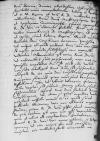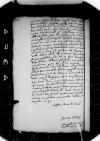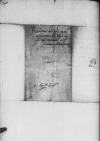⌊⌋ in ⌊Urbem⌋ et
s(erenissimae) or s(acrae)⌈s(erenissimae)s(erenissimae) or s(acrae)⌉
⌊maiestatis regiae⌋ et Vestrae Reverendissimae Dominationis mittentur per cubicularium reverendissimi written over um⌈umii written over um⌉ domini written over um⌈umii written over um⌉ ⌊archiepiscopi written over um⌈umii written over um⌉ Gnes(nensis) et episcopi written over um⌈umii written over um⌉ Cracoviensis written over em⌈emisis written over em⌉⌋, quarum exempla Reverendissima Dominatio Vestra iis adiuncta habebit. Feret eas in ⌊urbem⌋ ⌊cancellarius⌋ domini ⌊archiepiscopi⌋, ad quem paper damaged⌈[m]m paper damaged⌉ et ipsum sunt litterae regiae. Quod moliri paper damaged⌈[i]i paper damaged⌉ dicuntur ⌊domini consiliarii terrarum Prussiae⌋, ut munus aliquod mittant reverendissimo ⌊domino meo Chelmensi paper damaged⌈[mensi]mensi paper damaged⌉⌋, id nescio quomodo subolfecisse iam nonnulli videntur. Admonitus est enim ⌊reverendissimus dominus⌋, ut rationibus suis prospiceret, nam eas in ⌊Prussia⌋ impeditas iri. Id, quid sibi velit, non satis intelligit ⌊reverendissimus dominus⌋, sed suspicatur aliquid de iis, quae ⌊domini consiliarii⌋ promiserunt. Numquam fuerunt, quam nunc sunt, tempora difficiliora, ita ut ubivis terrarum quam in aula versari sit satius. Omnia plena sunt suspicionibus.
Sperat ⌊reverendissimus dominus⌋ facturos ⌊dominos consiliarios⌋, ut etiam si quis impedire volet paper damaged⌈[t]t paper damaged⌉, perstent nihilominus in eo, quod sunt polliciti. Quoniam vero non alterius magis favore, quam Reverendissimae Dominationis Vestrae isthaec fiunt omnia, de qua certum est eam non esse variaturam, quin et alios ad constantiam hortaturam, fecerit Reverendissima Dominatio Vestra veri amici officium, si dederit paper damaged⌈[t]t paper damaged⌉ operam, ut cum munus hoc erit corrasum, causam, cur mittatur, scribi curaverit, ne  BCz, 1618, p. 396 cui secus suspicandi detur occasio. Causa autem haec perscribi possent: quod cum non ignorent hidden by binding⌈[nt]nt hidden by binding⌉ hidden by binding⌈[] hidden by binding⌉ domini consiliarii reverendissimum dominum alumnum fuisse hidden by binding⌈[sse]sse hidden by binding⌉ reverendissimi domini ⌊Petri olim Tomitii⌋, cuius praeclara hidden by binding⌈[ra]ra hidden by binding⌉ virtus toti fere orbi est notissima, in spem adducti sint, fore ut patroni sui mortui, in hidden by binding⌈[in]in hidden by binding⌉ cuius officium successit, vestigia persequatur hidden by binding⌈[ur]ur hidden by binding⌉. Cuius rei cum iam non obscura signa dederit cumque coniecturam faciant ⌊domini consiliarii⌋ et ex virtutibus eius ac meritis hidden by binding⌈[tis]tis hidden by binding⌉ hidden by binding⌈[] hidden by binding⌉, et quod eo loco est apud
s(erenissimam) or s(acram)⌈s(erenissimam)s(erenissimam) or s(acram)⌉
⌊maiestatem regiam⌋, unde aditus aliis ad maiores dignitates hidden by binding⌈[es]es hidden by binding⌉ semper patebat, fore ut in hac vacatione hidden by binding⌈[e]e hidden by binding⌉ dignitatum altius ascendat, non potuisse hidden by binding⌈[e]e hidden by binding⌉ eos facere, quin hoc illum munere honestarent, ut subsidium aliquod ad solvendas annatas habere possit. In hanc hidden by binding⌈[c]c hidden by binding⌉ sententiam si scribi litteras curaverit Reverendissima Dominatio Vestra, cum se ⌊dominosque alios consiliarios⌋, tum ⌊reverendissimum dominum⌋ omni suspicione liberabit. In quam ita facile nunc incurritur, ut neque scribere, neque dicere propemodum iam aliquid tutum sit.
BCz, 1618, p. 396 cui secus suspicandi detur occasio. Causa autem haec perscribi possent: quod cum non ignorent hidden by binding⌈[nt]nt hidden by binding⌉ hidden by binding⌈[] hidden by binding⌉ domini consiliarii reverendissimum dominum alumnum fuisse hidden by binding⌈[sse]sse hidden by binding⌉ reverendissimi domini ⌊Petri olim Tomitii⌋, cuius praeclara hidden by binding⌈[ra]ra hidden by binding⌉ virtus toti fere orbi est notissima, in spem adducti sint, fore ut patroni sui mortui, in hidden by binding⌈[in]in hidden by binding⌉ cuius officium successit, vestigia persequatur hidden by binding⌈[ur]ur hidden by binding⌉. Cuius rei cum iam non obscura signa dederit cumque coniecturam faciant ⌊domini consiliarii⌋ et ex virtutibus eius ac meritis hidden by binding⌈[tis]tis hidden by binding⌉ hidden by binding⌈[] hidden by binding⌉, et quod eo loco est apud
s(erenissimam) or s(acram)⌈s(erenissimam)s(erenissimam) or s(acram)⌉
⌊maiestatem regiam⌋, unde aditus aliis ad maiores dignitates hidden by binding⌈[es]es hidden by binding⌉ semper patebat, fore ut in hac vacatione hidden by binding⌈[e]e hidden by binding⌉ dignitatum altius ascendat, non potuisse hidden by binding⌈[e]e hidden by binding⌉ eos facere, quin hoc illum munere honestarent, ut subsidium aliquod ad solvendas annatas habere possit. In hanc hidden by binding⌈[c]c hidden by binding⌉ sententiam si scribi litteras curaverit Reverendissima Dominatio Vestra, cum se ⌊dominosque alios consiliarios⌋, tum ⌊reverendissimum dominum⌋ omni suspicione liberabit. In quam ita facile nunc incurritur, ut neque scribere, neque dicere propemodum iam aliquid tutum sit.
Deum precor, ut Reverendissimam hidden by binding⌈[Reverendissimam]Reverendissimam hidden by binding⌉ Dominationem Vestram diu servet incolumem et felicem hidden by binding⌈[m]m hidden by binding⌉. Cuius me gratiae commendo.
 BCz, 1618, p. 396 cui secus suspicandi detur occasio. Causa autem haec perscribi possent: quod cum non ignorent hidden by binding⌈[nt]nt hidden by binding⌉ hidden by binding⌈[] hidden by binding⌉ domini consiliarii reverendissimum dominum alumnum fuisse hidden by binding⌈[sse]sse hidden by binding⌉ reverendissimi domini
BCz, 1618, p. 396 cui secus suspicandi detur occasio. Causa autem haec perscribi possent: quod cum non ignorent hidden by binding⌈[nt]nt hidden by binding⌉ hidden by binding⌈[] hidden by binding⌉ domini consiliarii reverendissimum dominum alumnum fuisse hidden by binding⌈[sse]sse hidden by binding⌉ reverendissimi domini 

